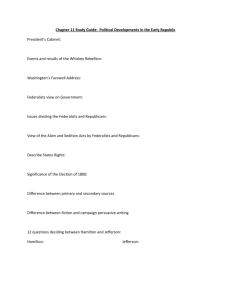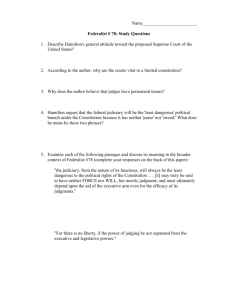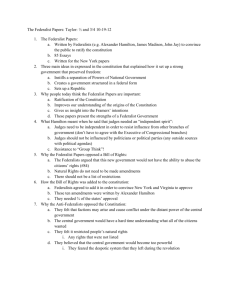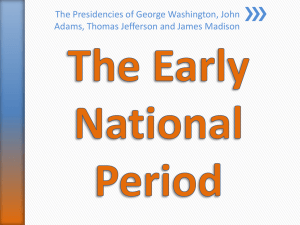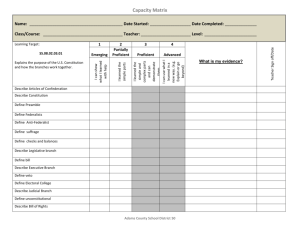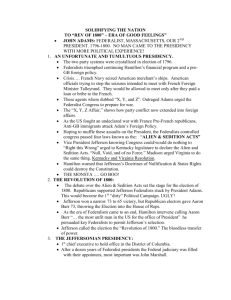Chapter 6 PowerPoint
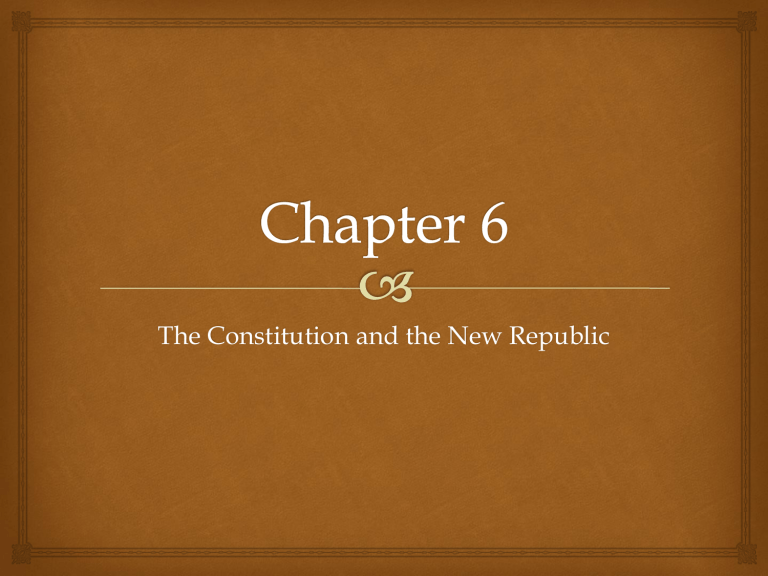
The Constitution and the New Republic
Framing a New
Government
Chapter 6.1
Advocates of Centralization
Americans feared the power of a central/federal/national government
Wanted to maintain State’s rights and powers
The government under the A of C was hampered by
Factions (different groups within the whole)
Instability
Inability to deal with economic problems (inflation, taxes, etc.)
Failure to deal with Shay’s Rebellion made it look bad
Lack of power to solve social unrest (like veteran affairs and slavery)
Merchants, wealthy landowners, and traders wanted to standardize the economic system… WHY and what does standardization mean?
Alexander Hamilton and James Madison join forces to call for a
Constitutional Convention—where delegates will meet to overhaul the
A of C and strengthen the central government so that they could have the power to PASS TAXES
A Divided Convention
55 “Founding Fathers” met in Philadelphia in September of 1787
Generally they were group of people who distrusted any concentration of power but new they needed a stronger government
Washington chosen as President of the Convention
Voted to close the meeting to the public and press… Why is this significant?
James Madison introduced the Virginia Plan—bicameral legislature
(House=based on population, Senate=based on votes of the House)
Large states have a huge advantage
New Jersey Plan—unicameral legislature equally represented, gave congress powers to tax and regulate trade
Gave advantage to small states
Argument over whether slaves should be counted for taxation…
WHY? What would be the North’s position? What would be the
South’s?
Compromise
Convention bickered for months, could not decide
Great Compromise —July, 1787 Convention agreed to legislature and representation
House=based on population
Slaves count as 3/5 of a person but cannot vote
Why would slave states want slaves to count as population?
Senate=every state gets 2 representatives
South prevented North from taxing the slave trade or for stopping the slave trade for 20 years
The Constitution of 1787
James Madison—the father of the Constitution
Solved the issues of…
Sovereignty—power flowed from the people NOT from the government
“We the people…”
Divided Power—Federal and State government shared power—a Republic
Limiting Power—Separation of powers created a system of checks and balances within the three branches of government and the state/federal government
Federalists and Antifederalists
Convention feared that the Constitution wouldn’t be ratified under the A of C (which required a unanimous vote) so they changed the rules and required only 9 states to ratify.
All states but Rhode Island ratified it.
Federalist Papers—written by Hamilton, Madison, and Jay and published in Newspapers, supported the constitution.
Supporters came to be known as Federalists
Antifederalists—feared a possibly tyrannical centralized government and did not like that the constitution because it lacked a Bill of Rights
Completing the Structure
Elections took place in early 1789, overwhelmingly
Federalists won.
George Washington became President and John Adams became Vice President
Congress’s first task was to draft a Bill of Rights— which the antifederalists were promised if they supported the formation of the new government (12 proposed, 10 ratified)
Congress created first Cabinet—Secretaries of State
(Thomas Jefferson), Treasury (Hamilton), and War (Henry
Knox)
Federalists and
Republicans
Chapter 6.2
AOC vs. Constitution
ARTICLES OF CONFEDERATION CONSTITUTION
LEVYING TAXES Congress could request states to pay taxes
No system of federal courts FEDERAL COURTS
REGULATION OF
TRADE
EXECUTIVE
AMENDING
DOCUMENT
No provision to regulate interstate trade
No executive with power. President of U.S. merely presided over Congress
13/13 needed to amend Articles
REPRESENTATION OF
STATES
Each state received 1 vote regardless of size
Congress has right to levy taxes on individuals
Court system created to deal with issues between citizens, states
Congress has right to regulate trade between states
Executive branch headed by President who chooses Cabinet and has checks on power of judiciary and legislature
2/3 of both houses of Congress plus 3/4 of state legislatures or national convention
Upper house (Senate) with 2 votes; lower house (House of Representatives) based on population
Congress can raise an army to deal with military situations
RAISING AN ARMY
Congress could not draft troops, dependent on states to contribute forces
INTERSTATE
COMMERCE
DISPUTES BETWEEN
STATES
No control of trade between states
Complicated system of arbitration
SOVEREIGNTY Sovereignty resides in states
Interstate commerce controlled by Congress
Federal court system to handle disputes
Constitution the supreme law of the land
PASSING LAWS 9/13 needed to approve legislation
Hamilton and the Federalists
Federalists dominated government for 12 years under the leadership of Hamilton (as leader of the party NOT the government)
Hamilton believed:
Stable and effective government required “enlightened” ruling class What does this mean?
Government was responsible for national and state debt— issues bonds to give the wealthy a stake in the country’s future
Created a federal bank—safe place to keep funds, collect taxes, and pay government expenses.
Government sold lands in the west to pay for bonds but it wasn’t enough
Government started taxing the production of Whiskey and putting tariffs on imports.
Enacting the Federalist Program
Some states (VA) did not like the Federal assumption of state debts from states with large debt (MA) so they compromised and moved the capitol from
Philadelphia to Washington D.C.
Bank of United States is created despite argument that Congress could not create the bank since the
Constitution did not specifically say it could.
The Republican Opposition
Madison warned that political parties were dangerous (Fed
Papers #10)
Because Federalists were in control of so much of the government, many wanted an opposing party—birth of the
Republican Party
First Party System—both sides argued that the other side had no
right to exist and that there were no political parties.
James Madison & Thomas Jefferson—leaders of the Republican party
Believed in States Right,
Believed in an “Agrarian Republic”—independent farmers
Feared growth of cities and industrialization
Federalists did not support the French Revolution while the
Republican did.
(common people of France over threw the French aristocracy)
Establishing National
Sovereignty
Chapter 6.3
Securing the Frontier
1791 PA farmers refused to pay whiskey excise tax, Washington called militia from 3 states, Whiskey Rebellion collapsed- intimidation won allegiance
Federal government won loyalty of frontiersmen by accepting territories as new states (NC 1789, RI 1791 last of 13 colonies)- VT 1791, Kentucky 1792,
Tennessee 1796
Native Americans and the
New Nation
Clashes with natives raised question of
Indians’ place in the federal structure.
Constitution recognized tribes as legal entities, but not outright nations
The Constitution did not address the main issue of land
Indians lived within US boundaries but the US offered them some measure of sovereignty
Maintaining Neutrality
In 1791 Great Britain sent first minister to US
question of US neutrality arose in 1793 when French government from revolution of 1789 went to war with Great Britain
French sent representative to US (Edmond Genet) violated
Neutrality Act and tried to recruit Americans to French cause-
US ships as privateers, raids against Spanish (who allied with
Britain)
British Royal Navy began seizing US ships trading w/ French in West Indies in 1794,
anti-British feelings high,
Hamilton concerned because war meant end to English imports
main revenue for financial system dependent from duties
Jay’s Treaty and
Pinckney’s Treaty
Hamilton feared pro-French State Dept, had Washington send
Chief Justice and Federalist John Jay to negotiate treaty with
Britain
Jay’s Treaty in 1794 failed to compensate Brit assaults on ships and withdrawal of Brit forces from frontier, but prevented war, established American sovereignty over Northwest, satisfactory commercial relationship
American backlash followed b/c not enough Brit promises,
Republicans and some Federalists offered opposition but ultimately ratified by Senate
Jay’s treaty allowed peace to be made with Spain b/c raised fears of Brit/American alliance in North America,
Pinckney’s treaty in 1795 recognized US right to Mississippi,
Florida border, control of Indian raids from FL
The Downfall of the
Federalists
Chapter 6.4
The Election of 1796
Washington retired from presidency in 1797,
in “Farewell” worried over foreign influence on gov’t, including
French efforts to frustrate Federalist diplomatic program
Party rivalry start sot take shape
Jefferson runs for Republicans,
Hamilton too many enemies so
VP John Adams becomes the Federalist candidate
Federalists could win majority of electors 1796 pres. election for
Adams but factional fighting within party caused second candidate Thomas Pinckney to receive many votes- resulted in
Jefferson finishing second, became VP.
Federalists divided, strong Republicans opposition, Hamilton still leads party
The Quasi War with France
US relations with Great Britain & Spain improved after treaties, deteriorated w/ France b/c of impressments of US ships and sailors
President Adams pursued reconciliation by appointing bi-partisan commission of Charles Pinckney, John Marshall, Elbridge Gerry to negotiate
French foreign minister Talleyrand demanded loan and bribe,
Adams turned over report to Congress w/ names deleted- “XYZ Affair” caused outrage at France,
Federalist gained support for response
Adams asked Congress to cut off trade, 1798 created Dept of Navy
(very successful capturing French ships), cooperated with Great
Britain
France reconciled, new government of Napoleon 1800
new commercial arrangements
Repression and Protest
Conflict with France led to Federalist majority 1798,
to silence Republican opposition Adams passed the Alien and Sedition Acts
Alien Act restricted foreigners becoming citizens,
Sedition Act allowed government to prosecute libelous or treasonous activity- but definitions allowed government to stifle any opposition—
Republicans fought back
Adams cautious in implementation but still repressive, Republican leaders hoped for reversal from state legislatures
Jefferson + Madison had VA, KY adopt resolutions arguing when government exercised undelegated powers, its acts “void”. Used
Locke’s “compact theory”: states were part of contract, fed govt had breached contract, therefore states could “nullify” the appropriate laws—only VA and KY did so
By late 1790s national crisis because nation so politically divided
The “Revolution” of 1800
1800 presidential election saw same candidates- Adams’ and Jefferson’s supporters showed no restraint or dignity in their assaults against other
Crucial contest in New York where Aaron Burr (candidate for VP) mobilized Rev War veterans, the Tammany Society, to serve as Republican political machine- Republicans eventually won the state and election
In partisan atmosphere Jefferson and Burr votes tied, the previous
Federalist Congress had to choose between the two in a vote (House of
Representatives decides when no majority), ultimately Hamilton and
Federalists elected Jefferson
After election only judiciary branch still Federalist, Judiciary Act of 1801 had created many new positions which Adams had filled before leaving office
Republican viewed victory as savior from tyranny, believed new era would begin where true founding principles would govern
Quizlet Study Session
Find a partner
Grab one laptop per group
Each group will be assigned two terms.
Sign in to Quizlet.com and join FLESSA APUSH
For each term:
Define it
Tell us why its important
Connect it to other events in the chapter
Give the Social, Economic, and Political influence of the term
